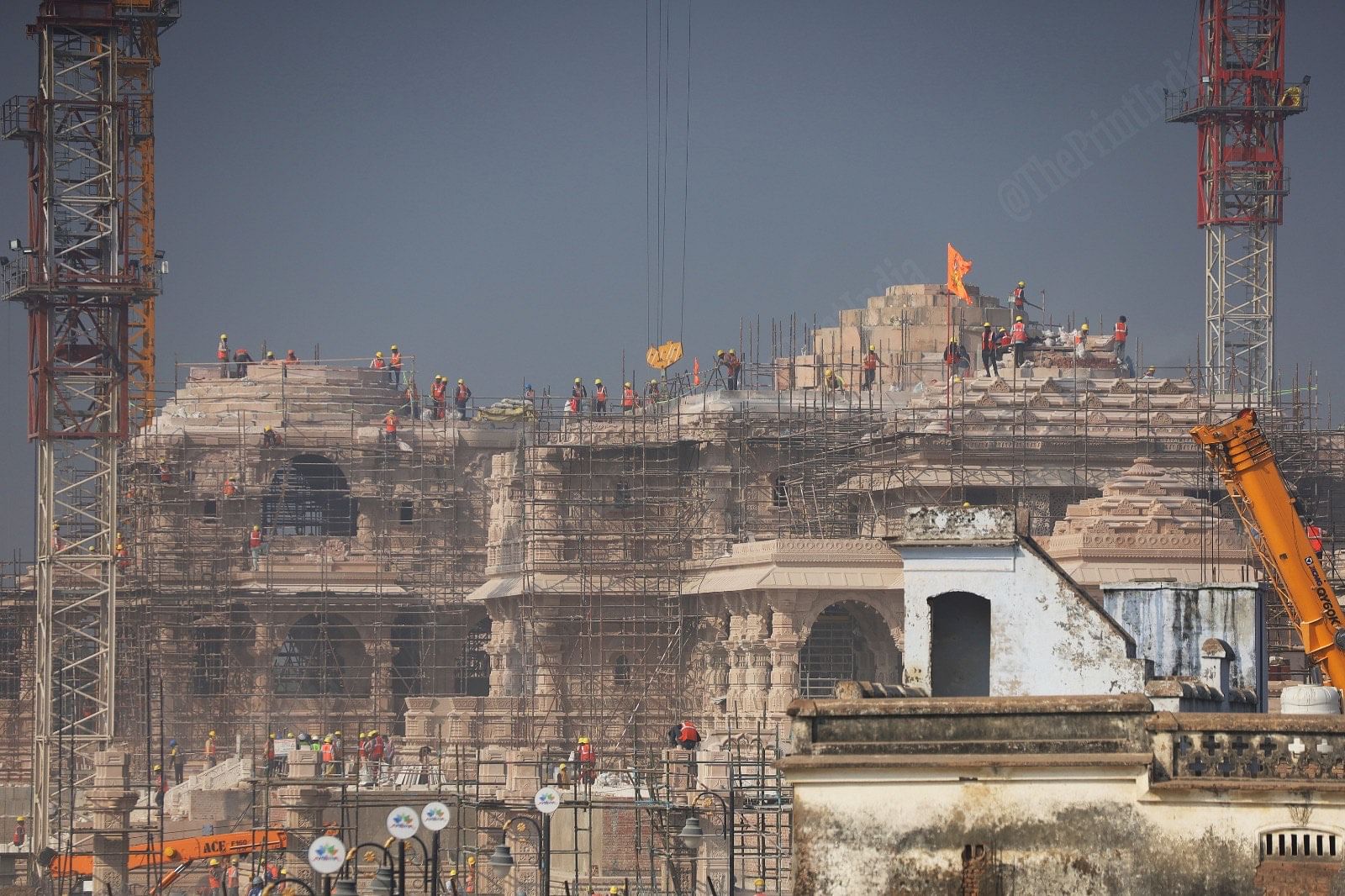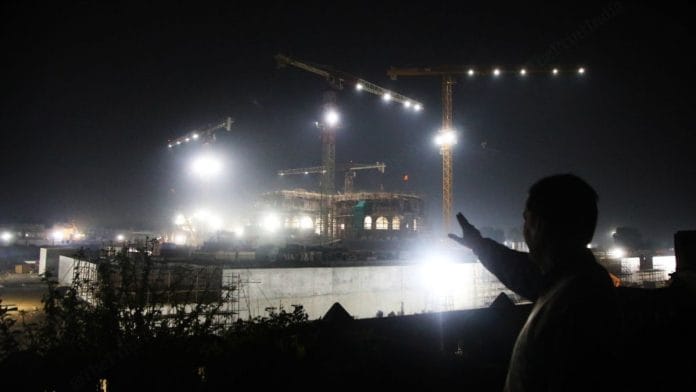Ayodhya: Gun-toting policemen stand atop seven watch towers installed 35 feet-above the ground; it’s the under-construction Ayodhya temple that they are securing. Like eagles in the sky. Their focus not only on some distant threat but also on the roofs of neighbourhood houses from where one could wave to UP CM Yogi Adityanath or watch PM Modi while they enter the temple premises. As soon as the guards spot a stranger atop these houses, they alert the force on ground on the walkie talkie to send someone to the house and ask the visitors to come down.
This is Ramkot in Ayodhya and the terraces and backyards in this neighborhood have seen the site that changed India and its politics — from demolition of the Babri Masjid to the first brick laid for the Ram Mandir by PM Modi. These are the houses that gave shelter to kar sevaks who marched towards the Masjid three decades ago; it was women of these houses who ran to their terraces to watch the demolition live that even television failed to capture.
But their delightful open home theater showcasing Ram temple construction is under the lens — CCTV cameras keep a track on their doors and policemen drop at their gates every now and then, apart from curious relatives and strangers who all invade their privacy. Everyone wants to see the temple-in-making. People sit on terraces, like spectators who climb a building to catch a cricket match live…all without a ticket.

Also read: Morbi is India’s undisputed tile champion. Now this Gujarat town is eyeing China’s crown
Daily darshan
Waving his hand, Siyaram Saini stood on his terrace to catch a glimpse of Chief Minister Yogi Adityanath during one of his many visits to the town to inspect construction work. “CM Yogi waved back,” Saini tells his friends, neighbours and relatives, bragging his fanboy moment.
A retired government official, Saini, 67 enjoys his cup of tea on the terrace watching the upcoming structure. He is joined by his wife, Madhuri and their grandchildren – a boy and a girl. Saini can recognise the workers from afar. The one wearing white helmet joined recently. The other one, wearing a yellow helmet and green jacket, has been working for the last two years.
A worker wearing yellow helmet and neon green vest jacket sits on a crane that transports him to the third floor of the Ram temple. Iron rods are jutting out, scaffolding is being installed and concrete mixer is rolling. On the ground, workers are chiseling the stones meant for construction. In another corner, workers have broken for tea. A saffron flag flutters on the spire at the entrance that will be inaugurated on 22 January.
“They (the workers) don’t know me but I know them by their clothes and contours. They work relentlessly and are the real force behind,” said Saini, pointing at the temple site.
And all this attention has security headache for the authorities.
“We are paying special attention to the neighborhoods surrounding the Ram temple. We have put a proper surveillance system in place. We have CCTV cameras everywhere. We review these houses every day and know how many people live in these houses. We even know who is visiting them. We have drones hovering over such houses,” said Ayodhya IG Praveen Kumar.
Ayodhya police have created a special branch that overlooks these houses and carries out drills regularly. The location of these houses are a threat to security as anyone can find the way to Ram temple, the police said.

Also read: Ex-service chiefs have no place at Ram Temple inauguration. They must guard military values
Critical location
When PM Modi came to Ayodhya to perform bhoomi pujan in August 2020, Special Protection Group (SPG) commandos had occupied the terrace of Anil Dwivedi’s two-storey house. Only Dwivedi and his family members were allowed on the terrace.
“Many journalists came to my house to get a picture of Modi’s visit but they were not allowed to enter the terrace area by the commandos,” recalled Dwivedi, a small-time businessman.
This was not the first time his terrace gave people the bird’s eye view. In the aftermath of masjid demolition, Dwivedi’s terrace had become the vantage point for photojournalists.
And during the 2005 Ram Janmabhoomi terror attack, it was Dwivedi’s house where TV journalists and photographers scrambled to take pictures discreetly – hiding from police eyes.
But not for long. “Soon, the police force came, inspected the backyard and terrace of all the houses and asked them to leave,” said Dwivedi.
Since then, Dwivedi, aware of the critical location of his house, has been cautious about allowing strangers in. However, since the construction of the Ram temple, he has found it challenging to maintain this privacy.
“Journalists show up and drop references. Sometimes, they say that they have been sent by some officer, other times they request earnestly. There is not much we can do. I am paying the cost of my privacy for the temple,” said Dwivedi.
For security personnel, the threat of a breach emanating from these nearby houses is real.
Ahead of the Ram temple inauguration on 22 January 2024, there are plans to barricade the neighborhood.
“We are carrying out a daily review and the houses are numbered on our map. We are trying to create Ram temple as the new pilgrim point and we need to ensure that everything is under control,” said Kumar.
The black iron grill at Saini’s house is not opened without checking who is standing outside the boundary wall that runs around the building. If he doesn’t know the person, he requests them to leave.
“Everyday someone comes to see the mandir. My house has become a cinema hall,” Saini laments.
Also read: ‘Want to buy peace’—Narendra Jain can’t get Salman Rushdie to end a 5-decade legal battle
The local oral chroniclers
In 2020, when PM Narendra Modi and Uttar Pradesh CM Yogi Adityanath performed the bhoomi poojan, Saini and Diwevdi went to their terrace and performed pooja from their respective balconies even as SPG commandos stood guard.
As Modi and Yogi left the temple premises, the neighbours cried “Jai Shree Ram” and clapped.
As the excitement around the temple grows, many locals are reflecting on the significance of the Ayodhya Express and its role in bringing devotees to the site, marking a new chapter in the city’s history.
In a matter of days, the mandir area was covered with huge tin sheets blocking the view to the neighborhood, Saini recalled.
“The tin sheets were there for a couple of months and were removed once the ground was laid,” said Saini.
TV has used temple maps and graphics over the past three years to chart the progress and vision of the biggest Hindu project and inform the faithful. Ramkot residents have seen it all ahead of live TV.
Now, every morning, his wife Madhuri goes to her backyard and prays while looking at the temple. They have seen the temple grow from one brick to a humongous structure with big cranes dotting the 70 acre of land.
Initially, the construction work at the temple started at a sluggish pace. Divewdi said that completing two floors within a year’s time seemed unattainable. However, with the announcement of the inauguration date in September, there was a significant pick up in the pace of construction.
The next morning, Divwedi saw the influx of new labourers arriving at the site, accompanied by installation of more cranes and mechanical equipment. The work is on 24*7 with workers operating in three shifts.
“We marvel at the big cranes brought by the authorities for the construction. They are hi-tech and cover half of the manual work,” said Saini.
TV has used temple maps and graphics over the past three years to chart the progress and vision of the biggest Hindu project and inform the faithful. Ramkot residents have seen it all ahead of live TV.
In the night, Divwedi and his family of four go upstairs and wave at the workers and appreciate them for the good work. The Ram temple, which is under construction, is gleaming under huge street lights. In the silence of the night, the whirring of machines is clear, cranes are moving and workers can be heard from his house.
“You are the real soldiers,” Diwevdi shouts.
But the construction work won’t reach completion before two years, said Champat Rai, trustee of Shri Ram Janmbhoomi Teerth Kshetra.
“However, the ground area for inauguration is completed and will be open by January 22,” said one of the Ram temple trustees, Champat Rai.
Also read: Ayodhya is being rebooted, rebuilt, & reimagined— Gen Z pilgrims, luxury hotels, 3D shows
Eye witnesses
It was Saini’s house where journalists had taken refuge in the aftermath of the Babri temple demolition. Saini’s wife Madhuri helped them escape the violent mob, she said. After the police came, and the mob grew silent, she helped journalists discreetly leave her house.
Nobody was allowed to give shelter to journalists. Days before the demolition, the neighborhood was alerted by the Right-wing groups to keep their houses open for the kar sevaks as they are doing the work of the god, Madhuri said.
Women were making puris, tea and lassi for the karsevaks who had taken shelter in their houses. Their terraces were used to map the plan, the neighborhood recalled.
Our neighborhood was swamped with kar sevaks. This was the only way to reach the disputed site. There was Uma Bharti too. I remember when she said ‘Ek dhakka aur do Babri Masjid tod do’ and that’s when it started
–Siyaram Saini, Ramkot resident
In Ramkot, which got its name for being the durbar of lord Ram, some women stacked bricks in their backyard and stood on them to witness the demolition of the “dancha” (mosque structure).
“The men were not letting women step out. We were restricted to the kitchen to serve the kar sevaks,” she said.
On 6 December 1992, as the karsevaks grew in numbers and the spirits went high, Saini joined the mob.
“Our neighborhood was swamped with kar sevaks. This was the only way to reach the disputed site. There was Uma Bharti too. I remember when she said ‘Ek dhakka aur do Babri Masjid tod do’ and that’s when it started,” said Saini sipping tea.
SalikRam Sharma, who had a slipped disc condition, couldn’t move but was eager to witness the masjid demolition. So, he asked his brother to move his cot to the terrace and take him upstairs on his back. He got his cot positioned in such a manner that he had the best view of the masjid. Sharma, 75 wanted to be a part of the “historic movement” at any cost. And now, he shares this story with his grandchildren.
“I saw men scrambling to reach the top of the tomb. They kept trying,” Sharma recalled with a smile on his face.
When a few men reached the stop and brought down one of the tombs.
Sharma yelled, “Jai Shree Ram,” raising his fist in the air while he lay on the cot.
(Edited by Anurag Chaubey)






